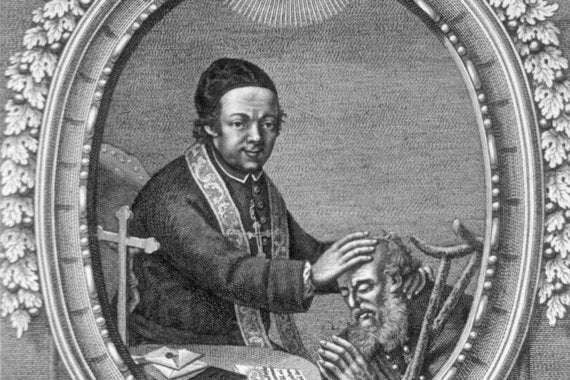
*Nikolas Oktaba is a Gates Cambridge Scholar doing an MPhil in Classics at the University of Cambridge. Picture credit of Johann Gassner c/o Wikimedia.
It is tempting to suppose that 'science' or 'reason' have unseated the rule of 'myth' or 'magic'. However, it is important to remember that fantastic interplay exists between the rational sciences and magic. Beliefs which we might brand as naïve and irrational today have actually contributed towards the advancement of scientific knowledge.
On March 14, American Congressmen used this reasoning to introduce a resolution enshrining magic as a "national treasure", noting that "many technological advances can be directly traced to the influential work of magicians". They argue that magic encourages people to interrogate their beliefs and is also a useful educational tool for children with disabilities. One Representative asked why the House GOP believes in magic but not global warming. Many have expressed incredulity that magic should be the focus of a resolution in the House of Representatives, conflating the magic hats of party magicians with the witches of Salem or Harry Potter. Whether these tricks facilitate children's development is irrelevant to their argument, as it is far too easy to reduce it to yet another instance of, 'The House GOP is being utterly ludicrous'. While it is true that the House GOP ought to do more to address global warming, and as soon as possible, this derision splinters those watching and those directly involved into uncomprehending factions bent on discrediting their supposedly juvenile opponents.
Johann Joseph Gassner
We like to think that we are more reasonable than those who came before us, but reason and logic have never been fully secure against superstition and belief. Perhaps that is what makes the life of Johann Joseph Gassner (1727-1779) so compelling.
During his heyday, Gassner is said to have healed thousands of people from all walks of life. The image of so many people going to see a Catholic exorcist may not sit well with our initial perception of the late eighteenth century. After all, the 1770s were the decade of Adam Smith, the final volume of Diderot's Encyclopédie, and the American Revolution. How, then, could an exorcist command such attention?
He was a consummate showman and a charismatic orator. He believed that devils could cause all manner of disorder, though not as the result of witchcraft. In fact, possession did not even have to be characterized by symptoms that we are familiar with from The Exorcist. Demons could disguise themselves as nature so adroitly that sometimes only an exorcism could heal even the most banal ailments. If a stubborn cold kept returning, then it could be caused by a demon. Gassner also claimed that some illnesses, being natural-but-not-demonic, could not be helped by his treatment; he could not cure a damaged Achilles tendon, but immediately set about expelling demons from people afflicted by gout.
By 1775, he was already famous through all of Germany and parts of France. His treatment was a combination of more orthodox methods of exorcism with touching afflicted body parts. This practice led him into direct conflict with Dr. Mesmer. In 1774, Mesmer discovered that he could manipulate certain forces within his patients' bodies in order to heal them. He called this treatment 'animal magnetism'. He quickly became famous in Austria, even impressing Mozart with his healing touch. Mesmer's treatment was largely similar to Gassner's, and Mesmer accused the latter of not only using his methods, but also taking advantage of people's superstition to market it.
Ironically, Gassner fared better than Mesmer in the face of concerted scientific enquiry. In 1775, he passed tests by four professors of the University of Ingolstadt with flying colors. In 1784, a commission including Benjamin Franklin condemned Mesmer's methods. Gassner did, however, face criticism for the social and fiscal effects of his popularity. In fact, many Catholics who voiced their opposition to Gassner did so on these, not theological, grounds.
Popular interest
Anything that caused social disorder was immediately suspect. Gassner attracted thousands of commoners, and the prospect of so many commoners gathering for any reason was frightening to absolute rulers. Gassner's campaigns also had economic ramifications. Books and pamphlets about him sold in the thousands, and unscrupulous pharmacists sold all manner of potions and medicines supposedly blessed by him. Perhaps the worst result of Gassner's travels, according to some authors, was that wealth was flowing from surrounding imperial territories to regions such as Ellwangen when they were more desperately needed in their respective homes.
Invalids required assistants to reach Gassner, and each assistant required some form of compensation. They needed places to stay along the journey, and so did the gawkers who would travel to watch Gassner. They would wait weeks for a session with the Father; all of them would require room, board, and souvenirs to take back home. Soldiers were needed to maintain order, and each soldier required pay. One author projected Gassner's cost to surrounding territories at one million gulden. He was also accused of making Enlightenment Germany an easy target for ridicule. These objections brought Gassner's career to an end, and the polarizing priest was forced to assume regular parishional duties in a small town called Ponsdorf.
His campaign and its controversies foreshadowed many of the great debates of the nineteenth century in the literary, religious, political, and intellectual spheres, and his treatments survived in the nucleic origins of psychoanalysis. Whatever we think of demons or religion, Gassner is not a discrete phenomenon of the Enlightenment. As H.C. Erik Midelfort writes in the epilogue to his excellent volume on Gassner, his life foreshadowed further debates in the relation of modernity to postmodernity and the role of superstition and belief in ages of scientific enlightenment. If anything, the recent controversy over this resolution shows that these questions are still relevant today.
